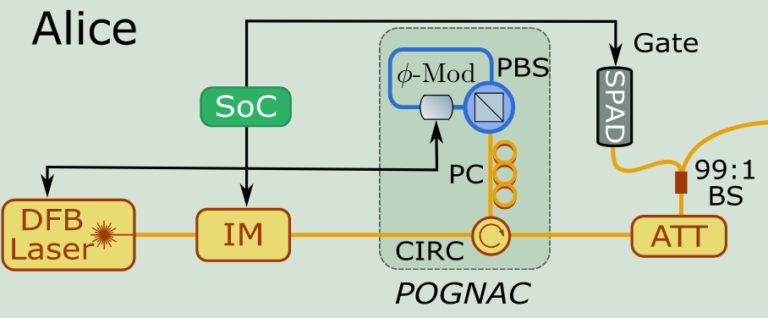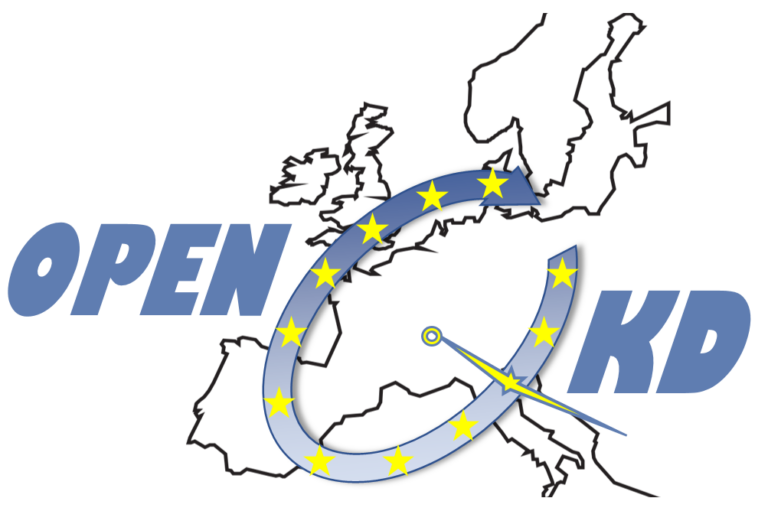
Quantum Key Distribution (QKD) relies on quantum communication to allow distant parties to share a secure cryptographic key. Widespread adoption of QKD in current telecommunication networks will require the development of simple, low cost and stable systems. However, current QKD implementations usually include additional hardware that perform auxiliary tasks such as temporal synchronization and polarization basis tracking. Here we present a polarization-based QKD system operating at 1550 nm that performs synchronization and polarization compensation by exploiting only the hardware already needed for the quantum communication task. Polarization encoding is performed by a self-compensating Sagnac loop modulator which exhibits high temporal stability and the lowest intrinsic quantum bit error rate reported so far.The QKD system was tested over a fiber-optic link, demonstrating tolerance up to about 40 dB of channel losses. Thanks to its reduced hardware requirements and the quality of the source, this work represents an important step towards technologically mature QKD systems.

È partito da quest’anno il progetto triennale Quasar (QUAntum SAfe Randomness), finanziato dalla Fondazione Cassa di Risparmio di Padova e Rovigo, che si occuperà della generazione di numeri casuali con tecniche quantistiche. La generazione di numeri casuali è di fondamentale…

IlSole24Ore, nella sua edizione cartacea del 9 dicembre 2019, ha parlato del nostro Dipartimento di Ingegneria dell’Informazione. QuantumFuture è presente grazie alla partecipazione al progetto europeo OPENQKD. OPENQKD (www.openqkd.eu) è un progetto europeo triennale iniziato a settembre 2019 con un…

Quantum key distribution (QKD) allows distant parties to exchange cryptographic keys with unconditional security by encoding information on the degrees of freedom of photons. Polarization encoding has been extensively used for QKD along free-space, optical fiber, and satellite links. However, the polarization encoders used in such implementations are unstable, expensive, and complex and can even exhibit side channels that undermine the security of the protocol. In our recently published manuscript (Agnesi et al. Opt. Lett 44(10) 2398 (2019); https://doi.org/10.1364/OL.44.002398) we propose and test a new polarization encoder: the POGNAC (for POlarization SaGNAC). The POGNAC combines a simple design and high stability reaching an low intrinsic quantum bit error rate. Since realization is possible from the 800 to the 1550 nm band using commercial off-the-shelf devices, our polarization modulator is a promising solution for free-space, fiber, and satellite-based QKD.

Random numbers are commonly used in many different fields, ranging from simulations in fundamental science to security applications. In some critical cases, as Bell's tests and cryptography, the random numbers are required to be both secure (i.e. known only by the legitimate user) and to be provided at an ultra-fast rate (i.e. larger than Gbit/s). However, practical generators are usually considered trusted, but their security can be compromised in case of imperfections or malicious external actions. In this work we introduce an efficient protocol which guarantees security and speed in the generation. We propose a novel source-device-independent protocol based on generic Positive Operator Valued Measurements and then we specialize the result to heterodyne measurements. The security of the generated numbers is proven without any assumption on the source, which can be even fully controlled by an adversary. Furthermore, we experimentally implemented the protocol by exploiting heterodyne measurements, reaching an unprecedented secure generation rate of 17.42 Gbit/s, without the need to take into account finite-size effects. Our device combines simplicity, ultrafast-rates and high security with low cost components, paving the way to new practical solutions for random number generation.

Satellite-based quantum communication is an invaluable resource for the realization of a quantum network at the global scale. In this regard, the use of satellites well beyond the low Earth orbits gives the advantage of long communication time with a ground station. However, high-orbit satellites pose a great technological challenge due to the high diffraction losses of the optical channel, and the experimental investigation of such quantum channels is still lacking. Here, we report on the first experimental exchange of single photons from Global Navigation Satellite System at a slant distance of 20000 kilometers, by exploiting the retroreflector array mounted on GLONASS satellites. We also observed the predicted temporal spread of the reflected pulses due to the geometrical shape of array. Finally, we estimated the requirements needed for an active source on a satellite, aiming towards quantum communication from GNSS with state-of-the-art technology.

New techniques based on weak measurements have recently been introduced to the field of quantum state reconstruction. Some of them allow to directly measure each matrix element of an unknown density operator and need only d+1 different couplings between the system and the measuring device, compared to d2 in the case of standard QST for the reconstruction of an arbitrary mixed state. However, due to the weakness of these couplings, these protocols are approximated and prone to large statistical errors. We propose a method which is similar to the weak measurement protocols but works regardless of the coupling strength: our protocol is not approximated and thus improves the accuracy and precision of the results with respect to weak measurement schemes. We experimentally apply it to the polarization state of single photons and compare the results to those of preexisting methods for different values of the coupling strength. Our results show that our method outperforms previous proposals in terms of accuracy and statistical errors.

Entanglement is an invaluable resource for fundamental tests of physics and the implementation of quantum information protocols such as device-independent secure communications. In particular, time-bin entanglement is widely exploited to reach these purposes both in free-space and optical fiber propagation, due to the robustness and simplicity of its implementation. However, all existing realizations of time-bin entanglement suffer from an intrinsic post-selection loophole, which undermines their usefulness. Here, we report the first experimental violation of Bell’s inequality with “genuine” time-bin entanglement, free of the post-selection loophole. We modify the setup by replacing the first passive beam-splitter in each measurement station with an additional interferometer acting as a fast optical switch synchronized with the source. Using this setup we obtain a post-selection-loophole-free Bell violation of more than nine standard deviations. Since our scheme is fully implementable using standard fiber-based components and is compatible with modern integrated photonics, our results pave the way for the distribution of genuine time-bin entanglement over long distances.

A step forward in satellite quantum communication on a planetary scale: the successful demonstration of tracking and synchronization between Micius, the satellite of the Chinese Academy of Sciences dedicated to quantum communication, and the ASI-MLRO observatory in Matera, with the…

One of the most surprising and counterintuitive aspects of Quantum Mechanics is the wave-particle duality, more precisely the impossibility of describing the fundamental elements of nature exclusively as waves or as particles. In fact, Quantum Mechanics requires all elementary particles to be treated contemporaneously as waves and as particles, but forbids both characters to be observed simultaneously. In 1978 John Archibald Wheeler conceived a Gedankenexperiment, or thought-experiment, that takes the implications of Quantum Mechanics to the extreme, demonstrating that a classical description would lead to a seeming inversion of the normal order of time and thus a violation of the causality principle. Building upon the results of our research group in Satellite Quantum Communications and as part of the collaboration between the Matera Laser Ranging Observatory of the Italian Space Agency, we published a manuscript (Vedovato et al, Sci. Adv. 2017;3:e1701180) where we perform the first satellite version of Wheeler’s Gedankenexperiment. By exploiting the polarization degree of freedom and the temporal modes of photons reflected by satellites in a low Earth orbit, we demonstrated the necessity of the quantum treatment in the hostile space environment. Furthermore we have paved the way for further tests and applications of quantum theory in Space.










